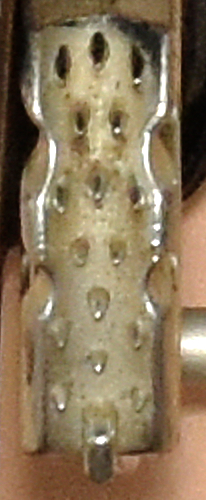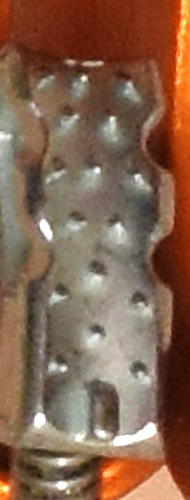Overview
History
Anthron was a family-owned company in Slovenia founded in 1989. They produced various handleless, handled, and chest eccentric cam ascenders, descenders, pulleys, and similar devices. I do not know when they developed this line of ascenders, but it was well before 2001.
Albrecht von Dewitz founded VuaDe in 1974, naming the company after his initials "V.D." (pronounced fau'de). VauDe sold Anthron ascenders under the VauDe brand. I have handleless, handled, and chest eccentric cam ascenders with VauDe markings that match Anthron handleless, handled, and chest eccentric cam ascenders respectively. They use the same model numbers that Anthron used. Four of the handled ascenders came in Anthron boxes.
The Spanish company Lucky sold Anthron ascenders under their brand name. My Lucky handleless ascenders have "lucKY" stamped onto
the rear and Anthron's triangle and double arrow logo stamped onto the front. My Lucky handled ascenders have "lucKY" stamped onto
the front strap and Anthron's triangle and double arrow logo stamped onto the front of the rope channel.
Mine Safety Appliances (Now MSA Safety) in the U.S.A. was founded in 1914 in response to the 1912 Jed Mine explosion that claimed 80 lives. Working with Thomas Edison, they introduced the first electric cap lamp for mining, reducing mine explosions by 75% over the next 25 years. They later expanded into other workplace safety markets, including rescue and fall protection.
Bob Thrun´s files had a DMM advertisement that offered essentially the same handled eccentric cam ascender under the DMM brand; however, I do not have their version in my collection. I have an Anthron handleless ascender that was sold as a DMM model AB20 ascender, but it has only Anthron markings.
Skylotec bought Anthron in 2016. I have a pair of their handled ascenders with Skylotec markings.
Here is a quick summary of the handled ascender versions in my collection:
[ Top
| Version B
| Version C
]
MSA Safety, Version A
(#3650)
Technical Details
I acquired this ascender from eBay seller justkillingtime53 in 2024.
This ascender is 203 mm. tall, 92 mm. wide, 32 mm. thick, and weighs 214 g.
 The shell is a tall irregular shaped stamping made from 4.0 mm. aluminum alloy sheet metal. The stamping has one reinforcing
rib behind the cam, but none along the sides of the hand opening.
A 15 mm. wide rope channel is formed in the upper portion of one side and
a smaller cam channel lies opposite the first. A hole drilled
through both sides of the cam channel accepts a 5 mm. roll
rivet. The cam and cam spring are mounted on this rivet. The handle
below the cam has a soft plastic hand grip molded into place.
The hand grip has four shallow finger grooves. A 16 mm. sling attachment hole is punched below the handle
opening, and an 11 mm. hole is punched below and outside this one. A 13.8 by 19.7 mm. oval hole through both sides
of the rope channel provides an attachment point just above the
cam, and a 15.6 mm. hole is punched through the rear of the
shell beside it. There is no cam stop.
The shell is a tall irregular shaped stamping made from 4.0 mm. aluminum alloy sheet metal. The stamping has one reinforcing
rib behind the cam, but none along the sides of the hand opening.
A 15 mm. wide rope channel is formed in the upper portion of one side and
a smaller cam channel lies opposite the first. A hole drilled
through both sides of the cam channel accepts a 5 mm. roll
rivet. The cam and cam spring are mounted on this rivet. The handle
below the cam has a soft plastic hand grip molded into place.
The hand grip has four shallow finger grooves. A 16 mm. sling attachment hole is punched below the handle
opening, and an 11 mm. hole is punched below and outside this one. A 13.8 by 19.7 mm. oval hole through both sides
of the rope channel provides an attachment point just above the
cam, and a 15.6 mm. hole is punched through the rear of the
shell beside it. There is no cam stop.
The cam is a plated skeletonized steel casting. The cam axle is centered 49 mm. from the inside of the rope channel. The cam radius, measured from the axle axis, increases from 38 to 52 mm. over an angle of 39°, giving a 24° cam angle. The tooth pattern is (3.2)^2(1.2)^2(B). The cam has
number of small conical teeth, all of which have their axes approximately
in line with the corresponding radius from the cam pivot. The tooth pattern is The tooth pattern is (3.2)^2(1.2)^2(B). Unlike some other ascenders, the inner cam face
radius appears to be constant. A spring-loaded manual safety bar
is mounted on the bottom of the cam with a small semi-tubular rivet. The
normal action of the spring holds the safety against the cam.
When the cam is opened, the shell interferes with the safety bar,
thus preventing opening the cam. If the safety bar is moved away
from the cam (opposing the spring), it will clear the shell and
the cam will open. At full open the safety can be released and
the spring will hold the safety against the back of the shell.
This provides a means of locking the cam open. A pin on the safety
assists in operating the safety mechanism.
The front of the ascender has "AD-10," the Anthron triangle and double arrow logo, "ROPES," "ø8 - 13mm," and "3505-O" printed on the rope channel. The rear is printed with "CE0123," the MSA logo, and a "(FP) logo.
This is a well-made ascenders and perform much like the Petzl Ascension. All sharp edges have been
removed. The attachment points are simply holes in the shell, and
although well-rounded,
I consider their small radius too sharp for directly attaching
sling ropes. They are probably acceptably rounded for webbing
(or could be made so), but considering the proximity of the attachment
points to the main rope, I would recommend using a small maillon
for most attachments in order to reduce the risk of sling abrasion.
The lower attachment hole could theoretically have the same safety
problems as the one on Clog Version A.
The upper rope attachment hole is located very close to the main
rope. A carabiner through the upper attachment hole will probably
drag on the main line. Note that such a carabiner will prevent
putting the ascender on or off rope, so one’s climbing system
must be designed accordingly.
The safety is reasonably easy to use with one hand.
The ribbed handle is not comfortable for me because the ribs are
spaced poorly for my hand. The cam is very well made.
This ascender has the same pit lip disadvantage as the Clog and other stamped frame ascenders.
The shell is thicker that the one on the Camp
Pilot, Kong-Bonaiti, and Petzl
Ascension but it isn't reinforced as it is on those.
[ Top
| Version A
| Version C
]
MSA Safety, Version B
(#3651)
Technical Details

I acquired this ascender from eBay seller justkillingtime53 in 2024.
This ascender is 203 mm. tall, 92 mm. wide, 32 mm. thick, and weighs 215 g. The rope channel is 15 mm. wide. The cam axle is centered 47 mm. from the inside of the rope channel. The cam radius, measured from the axle axis, increases from 38 to 52 mm. over an angle of 39°, giving a 24° cam angle. The tooth pattern is (3.2)^2(1.2)^2(B).
There are two differences between this ascender and Version A.
First, this ascender has a cam stop. Second, the second carabiner hole at the top has been reduced to a 6.3 mm. hole.
The front of the ascender has "AD-10," "UP," the Anthron triangle and double arrow logo, "ROPES," "ø8 - 13mm," the Reading-Is-Dangerous icon, and "3412-098" printed on the rope channel. The rear is printed with "EN 567," "CE0123," the MSA logo, and an "(FP) logo.
This ascender came with a 12 mm. tether.
[ Top
| Version A
| Version B
]
MSA Safety, Version C
(#3652)
Technical Details
 I acquired this ascender from Zion Castor in 2024.
I acquired this ascender from Zion Castor in 2024.
This ascender is 203 mm. tall, 92 mm. wide, 32 mm. thick, and weighs 215 g. The rope channel is 15 mm. wide. The cam axle is centered 47 mm. from the inside of the rope channel. The cam radius, measured from the axle axis, increases from 38 to 52 mm. over an angle of 39°, giving a 24° cam angle. The tooth pattern is (3.2)^2(1.2)^2(B).
This version has a cork handle instead of the soft "rubbery" plastic handle found on the previous versions.
The front of the ascender has "AL-15," "UP," the Anthron triangle and double arrow logo, and a book-with-an-"i" logo. The rear is printed with "CE0123," "ø9 - 13mm," "EN 567-2013," "•EN-12841:2006B," the UIAA logo and "UIAA," the MSA logo, an "(FP) logo, a factory icon, "09/2022," and "3722–008."
The cork handle feels good, but I wonder about its durability.
This ascender came with a 12 mm. tether. It is too long for my needs, but I'm only 1.93 m. tall.
For Europeans who need to pay attention to such things, this version was certified to a narrower range of rope diameters than the previous versions.
[ Top
| Version A
| Version B
| Version C
]


